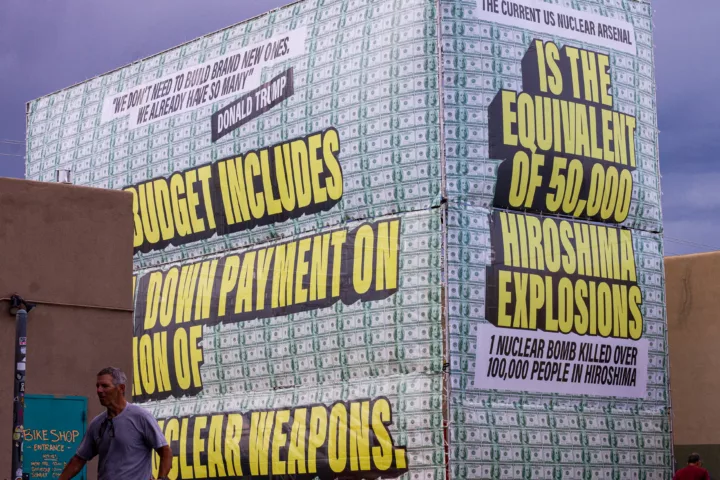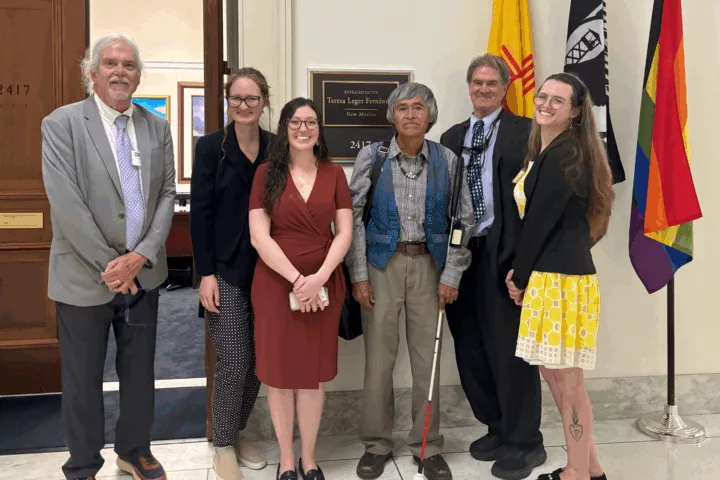Why NMED Should Deny LANL’s Request for Tritium Releases
The Los Alamos National Laboratory plans to begin large releases of radioactive tritium gas any time after June 2, 2025. The only roadblock to the Lab’s plans is that it needs a “Temporary Authorization” from the New Mexico Environment Department to do so.
Reasons why NMED should deny LANL’s request are:
- The state Environment Department has a duty to protect the New Mexican As it states, “Our mission is to protect and restore the environment and to foster a healthy and prosperous New Mexico for present and future generations.” 1
- Why the rush? LANL explicitly admits there is no urgency. According to the Lab’s publicly-released “Questions and Answers” in response to “What is the urgency for this project?”
“There is no urgency for this project beyond the broader mission goals to reduce onsite waste liabilities.” 2
-
- In addition, the National Nuclear Security Administration (NNSA) admits that the end time frame for action is 2028, not 2025.3 Therefore, there is time for deliberate consideration.
- Contrary to NMED’s Resource Conservation and Recovery Act permit for LANL, the Lab has not fulfilled its duty to inform the public via NMED of possible alternatives to its planned tritium releases.4 According to Tewa Women United, “LANL has told EPA there are 53 alternatives; that list of alternatives, initially requested in 2022, has not yet been Tewa Women United has repeatedly asked LANL to provide the public with that list.” 5
- Despite extensive prompting by the Environmental Protection Agency on possible better alternatives, the NNSA categorically rejected any modifications.6
- NNSA’s January 2025 draft LANL Site-Wide Environmental Impact Statement had no substantive discussion of the planned tritium releases, much less the required “hard look” at credible alternatives. Further, LANL and NNSA included these planned releases in the “No Action Alternative,” with the specious justification that “The Laboratory and NNSA have been integrating with the EPA and NMED to obtain approval to move forward with the plan to vent the Flanged Tritium Waste Containers currently located in TA-54.” Seeking approval makes them No Action? NNSA and LANL are legally required to consider public comments submitted for the LANL SWEIS. These planned tritium releases should not proceed until NNSA issues a Record of Decision on the final LANL Site-Wide Environmental Impact Statement.
- NNSA’s publicized maximum release of 30,000 curies is merely an administrative decision point at which LANL will stop the venting process to avoid exceeding the Clean Air Act’s 10 millirem public exposure limit for radioactive air emissions. It is not the potential total quantity of tritium that will have been released. LANL’s radioactive air emissions management plan sets an annual administrative limit of 8 millirem for the tritium releases, meaning venting will cease once this limit is reached but may resume in subsequent periods.7
- In addition, these planned releases are not necessarily a one-time event, as indicated above, contrary to what the LANL Site-Wide Environmental Impact Statement falsely states.8
- Nor are these planned releases strictly confined to just Area G, as claimed. 9
- LANL declares “There are no cumulative impacts from this operation. All limits are conservative, and well within regulatory limits that are protective of the ” 10 However, one independent report calculates that the effective dose to infants could be three times higher than to adults (therefore likely violating the 10 millirem Clean Air Act standard for “any member of the public”) and all of LANL’s calculated doses would be higher in the event of low wind speeds and low humidity.” 11 Another independent report noted how tritiated water can pervade every cell in the body while the planned LANL tritium releases are three times the amount of tritium that the crippled Fukushima nuclear power plant would release to the ocean over 30 years.12
- LANL claims “This critical milestone [the planned tritium releases] furthers the cleanup of Area G.” 13 But what so-called cleanup means to LANL is “cap and cover” of ~200,000 cubic yards of existing toxic and radioactive wastes at Area G, leaving them permanently buried in unlined pits and shafts as a permanent threat to groundwater. NMED knows this all too well given the draft order it issued to the Lab to excavate and treat all wastes at the smaller Area C waste dump, which LANL categorically NMED should carefully consider the extent to which approving these planned tritium releases is consistent with its desire for full comprehensive cleanup at the Lab, including Area G.
Recommendation: Given the self-admitted lack of urgency and remaining uncertainties in potential doses, times, locations and ultimate purpose of these planned tritium releases, NMED should deny LANL’s request for a “Temporary Authorization” to proceed until there has been an open and transparent analysis of alternatives and all possible public health impacts.
1 NMED home web page, https://www.env.nm.gov/, accessed April 24, 2025
2 Flanged Tritium Waste Containers, LANL, https://www.lanl.gov/engage/environment/ftwc, accessed 4-24-25
3 “The currently controlled venting process will be unfeasible at some point in the near future. Based on modeling, that time is likely less than 4-5 years (2028).” DOE/NNSA Response to July 27, 2023 letter, EPA Region 6, p. 4, parentheses in the original,, https://cdn.lanl.gov/files/ftwc-epa-response-attachment_3e0de.pdf
4 NMED Hazardous Waste Permit for LANL, February 2025, 1.9.7 Duty to Provide Information, https://www.env.nm.gov/hazardous-waste/wp-content/uploads/sites/10/2025/02/Permit-Parts-1-11_February-2025_Clean.docx
5 Tewa Women United, November 18, 2024, https://tewawomenunited.org/2024/11/press-release-new-report-reveals-lanl-tritium-venting-could-have-triple-the-radiation-exposure-to-infants-compared-to-adults
6 Undated NNSA Response to EPA Region 6 July 2023 letter, https://cdn.lanl.gov/files/ftwc-epa-response-attachment_3e0de.pdf
7 “The actual release of tritium would be dependent on the efficiency of the tritium capture system but not exceed 30,000 curies for any 12-month period. NNSA would limit annual tritium releases from FTWC venting to ensure that the total annual MEI dose (considering all sitewide releases) would remain less than 10 millirem/year. (Draft LANL SWEIS, Volume 2, PDF p. 281, parentheses in the original) The acronym MEI is for “maximally exposed individual” of the public (not workers).
8 For example, “The Laboratory could have a one-time release of up to 30,000 curies of tritium from venting flanged tritium waste containers.” Draft LANL SWEIS, Volume 1, page 5-44, emphasis added.
9 “A change in scope of planned operations, reflecting the potential for venting at multiple locations, was sent to EPA on March 5, 2020.” Notification of Planned Start of a Radiological Air Emissions Point Source: Remediation of Flanged Tritium Waste Containers (FTWC) at TA-54, LANL to EPA, April 3, 2025
10 Flanged Tritium Waste Containers, LANL, www.lanl.gov/engage/environment/ftwc
11 Review of LANL Radiation Dose Assessment for the Venting of Flanged Tritium Waste Containers (FTWCs) at TA-54 of Los Alamos National Laboratory, Bernd Franke, IFEU, Nov. 2024.
12 Out of Order: An evaluation of the regulatory aspects of Los Alamos National Laboratory’s proposal to vent tritium from waste containers, Dr. Arjun Makhijani, IEER, November 2024.
13 Request submitted to begin controlled release of Flanged Tritium Waste Containers at LANL, LANL, emailed public announcement, April 9, 2025.
This fact sheet is available at https://nukewatch.org/why-nmed-should-deny-lanls-request-for-tritium-releases
We urge citizens to sign a petition to NMED at https://actionnetwork.org/petitions/petition-to-deny-lanls-request-to-release-radioactive-tritium-into-the-air


